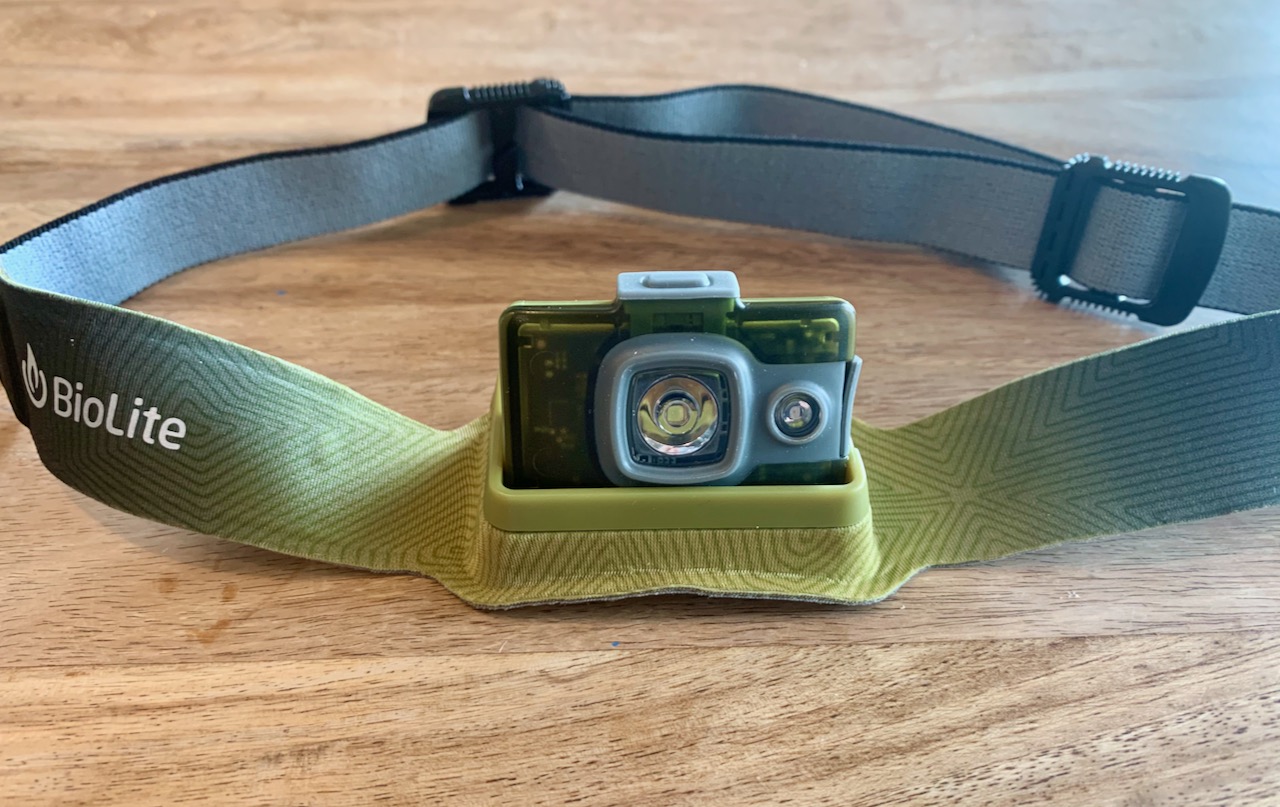BioLite is the main name that came up in reactions to our big solar panel review — many people wanted to know why they weren’t included. We didn’t know the brand was as popular as it apparently is until we made the mistake of leaving it out, so we reached out to them and not only did they send us a panel to test for our next review update, but they threw in one of their brand new lighting products: the HeadLamp 200.
I’m a big headlamp user — I have a fancy, all-metal, CR123A-powered Streamlight ProTac HL headlamp that I regularly use around the property. So I’ve enjoyed having the chance to spend some time with this new product the past few weeks. Here are some general thoughts and impressions.
Specs:
- MSRP: $44.95
- Battery life: 40 hours on low, 3 hours on high
- Weight: 1.75 oz
- Brightness: 5 lumens on low, 200 lumens on high
- Battery size: 700mAh
Basic features and usability
The HeadLamp 200’s number one feature is its insanely low weight — just 1.75 ounces. Even by lightweight headlamp standards, this is very low. When the sculpted design of the unit’s body is combined with the low weight of the light, the result is a headlight that’s comfortable to wear for extended periods and that doesn’t bounce when running.
This weight also makes it ideal for a bug-out bag, where it can be stashed and forgotten about until needed. Of course, I’ll need to spend a lot more time with this before I feel comfortable recommending it as a bug-out light, because right now I don’t have a good handle on the overall durability and longevity of this brand. But it does have potential as a BoB light.
The beam is pretty diffuse on this — there is quite a bit of spread, so you get a lot of coverage up-close but not much further out. This is good for walking, jogging, and working. But if you do need to suddenly throw the light quite a bit further out to illuminate something further afield, you’ll be out of luck. This isn’t the right tool for that job.
Speaking of using this for work, one of the nicer features is the way the light pivots out of the housing at different angles. There are three angled positions available, not counting the fully vertical one.
However, I have a bit of concern about this angle feature, from a prepping perspective, because I worry that it may detract from the durability of the light in the long-run. When the light is angled all the way down, it feels like it could snapped right out of the housing without too much force. If I were considering this for a bug-out or survival light, I’d strongly consider leaving it fully closed all the time, unless you’re charging it, in which case you have to open it out a bit to access the micro-USB slot.
The strap is lightweight, easily adjustable, and comfortable to wear for long periods. The only downside I can find to it, is that when you remove it from your head and handle it, it tends to lose its sizing pretty quickly. But when it’s on, the tension and friction keep the fit snug.
The strap fabric supposedly has some moisture wicking properties, but given how cold it has been I haven’t had the chance to really test that out.
Modes and operation
The HeadLamp 200 has a ton of modes and functions, and this variety is both a blessing and a curse. It’s a blessing because it boosts the light’s flexibility, but it’s a curse because all this complexity is managed via a single button that also functions as the power switch. Take a look at the following list, and think about the fact that you have to do timed button presses to activate all these things and/or switch in between them:
- Four lighting modes: white spot, white strobe, red flood, red strobe.
- A range of output levels, from low to high, for each mode.
- A lock mode, so the light can’t be accidentally turned on in a pack or purse.
- Battery check function, where certain flashes of certain colors tell you how much battery you have left.
There’s even a video that walks you through how to navigate all these functions:
This is lot to manage via a single button, and in fact my initial impression is that it’s too much. They should at least consider a separate slider or wheel of some sort for changing brightness levels. This wheel plus button combo is a common user experience (UX) pattern for many lights, and I think it would work well, here.
I may change my mind with further use, but really I just want the white spot, a dimmer, and a lock, and can do without the rest. Although if I were in a survival situation, the red flood would come in handy for night hunting (illegal, so don’t do it!).
One feature I really appreciate, because it mitigates the aforementioned complexity somewhat, is the mode memory. It remembers its last setting and powers on with it, so you don’t have to keep navigating back to your favorite mode from some default mode.
Conclusions
Overall, this is a solid little unit for general outdoor chores and activities, and it’s very good for running or jogging — especially in an urban environment, where you’re not likely to need a very long beam distance.
As a survival and preparedness light, the low weight and comfort are its biggest advantages. But I’d like to know more about its long-term durability before recommending it as a primary prep for a bug-out bag or home kit.
I also love that this recharges directly via micro-USB, a common plug format found on most of the solar chargers we’ve reviewed. This makes it easy to pair with solar for a camping trip or long-term bug-out.
If we leave aside durability questions for the moment, the HeadLamp 200 is very close to an ideal bug-out bag light, but I’d make the following changes:
- More waterproofing. Right now, it’s IPX4, which is a level of water resistant that makes it immune to sweat and light rain. I’d like to see a version that’s submersible for some length of time.
- No pivot. This is a nice-to-have feature, but if there were a version of this light that had no pivot and could be charged without it, it would feel a lot more bombproof.
- No modes other than white spot and locked. You don’t need anything else for prepping, and if you’re tired, stressed, or injured (all possibilities in an emergency situation) you may have a hard time fussing with this thing to get it to do what you want.
With these three relatively small changes, this would make it hard to beat as a prep. And even without them, it still may be a contender when it comes time to redo our headlamp review.




